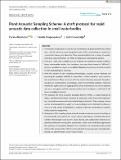Files in this item
Pond Acoustic Sampling Scheme : a draft protocol for rapid acoustic data collection in small waterbodies
Item metadata
| dc.contributor.author | Abrahams, Carlos | |
| dc.contributor.author | Desjonquères, Camille | |
| dc.contributor.author | Greenhalgh, Jack | |
| dc.date.accessioned | 2021-05-31T12:30:07Z | |
| dc.date.available | 2021-05-31T12:30:07Z | |
| dc.date.issued | 2021-05-01 | |
| dc.identifier | 274274910 | |
| dc.identifier | dd0d0873-d914-4d44-a8a6-c0f022484384 | |
| dc.identifier | 85105167209 | |
| dc.identifier.citation | Abrahams , C , Desjonquères , C & Greenhalgh , J 2021 , ' Pond Acoustic Sampling Scheme : a draft protocol for rapid acoustic data collection in small waterbodies ' , Ecology and Evolution , vol. Early View . https://doi.org/10.1002/ece3.7585 | en |
| dc.identifier.issn | 2045-7758 | |
| dc.identifier.other | ORCID: /0000-0002-6150-3264/work/95042182 | |
| dc.identifier.uri | https://hdl.handle.net/10023/23284 | |
| dc.description.abstract | 1. Freshwater conservation is vital to the maintenance of global biodiversity. Ponds are a critical, yet often under-recognized, part of this, contributing to overall ecosystem functioning and diversity. They provide habitats for a range of aquatic, terrestrial, and amphibious life, often including rare and declining species. 2. Effective, rapid, and accessible survey methods are needed to enable evidence-based conservation action, but freshwater taxa are often viewed as “difficult”—and few specialist surveyors are available. Datasets on ponds are therefore limited in their spatiotemporal coverage. 3. With the advent of new recording technologies, acoustic survey methods are becoming increasingly available to researchers, citizen scientists, and conservation practitioners. They can be an effective and noninvasive approach for gathering data on target species, assemblages, and environmental variables. However, freshwater applications are lagging behind those in terrestrial and marine spheres, and as an emergent method, research studies have employed a multitude of different sampling protocols. 4. We propose the Pond Acoustic Sampling Scheme (PASS), a simple protocol to allow a standardized minimal sample to be collected rapidly from small waterbodies, alongside environmental and methodological metadata. This sampling scheme can be incorporated into a variety of survey designs and is intended to allow access to a wide range of participants, without requiring complicated or prohibitively expensive equipment. 5. Adoption of this sampling protocol would enable consistent sound recordings to be gathered by researchers and conservation organizations, and allow the development of landscape-scale surveys, data sharing, and collaboration within an expanding freshwater ecoacoustic community—rather than individual approaches that produce incompatible datasets. The compilation of standardized data would improve the prospects for effective research into the soundscapes of small waterbodies and aid freshwater conservation efforts. | |
| dc.format.extent | 12 | |
| dc.format.extent | 1170630 | |
| dc.language.iso | eng | |
| dc.relation.ispartof | Ecology and Evolution | en |
| dc.subject | Acoustic monitoring | en |
| dc.subject | Bioacoustics | en |
| dc.subject | Ecoacoustics | en |
| dc.subject | Pond | en |
| dc.subject | Rapid assessment methods | en |
| dc.subject | Soundscape | en |
| dc.subject | Survey | en |
| dc.subject | QH301 Biology | en |
| dc.subject | Ecology, Evolution, Behavior and Systematics | en |
| dc.subject | Ecology | en |
| dc.subject | Nature and Landscape Conservation | en |
| dc.subject | DAS | en |
| dc.subject | SDG 14 - Life Below Water | en |
| dc.subject | SDG 15 - Life on Land | en |
| dc.subject.lcc | QH301 | en |
| dc.title | Pond Acoustic Sampling Scheme : a draft protocol for rapid acoustic data collection in small waterbodies | en |
| dc.type | Journal article | en |
| dc.contributor.institution | University of St Andrews. School of Biology | en |
| dc.identifier.doi | 10.1002/ece3.7585 | |
| dc.description.status | Peer reviewed | en |
| dc.identifier.url | https://onlinelibrary.wiley.com/doi/10.1002/ece3.7585#support-information-section | en |
This item appears in the following Collection(s)
Items in the St Andrews Research Repository are protected by copyright, with all rights reserved, unless otherwise indicated.

